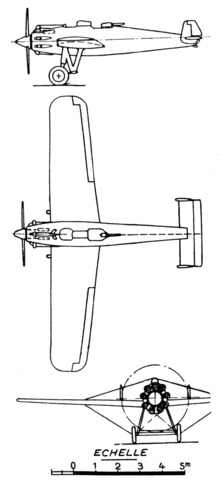Junkers K 47
The Junkers K 47 was a two-seater fighter aircraft developed in Sweden by the Swedish subsidiary of the German firm Junkers during the late 1920s, a civil development of which was designated the A 48.
| K 47 and A 48 | |
|---|---|
 | |
| Junkers A 48 | |
| Role | Fighter |
| National origin | Germany |
| Manufacturer | Junkers |
| Designer | Karl Plauth and Hermann Pohlmann |
| First flight | 15 September 1929 |
| Primary user | China |
| Number built | 23 |
Design and development
Designed to meet a requirement of the Turkish government for a new fighter, the K 47 was a strut-braced, low-wing monoplane of conventional design. Two open cockpits accommodated the pilot and tail-gunner, and the empennage was designed with twin vertical surfaces to maximise the rearward field of fire. The main units of the fixed, tailskid undercarriage shared part of the truss structure that braced the wings. The design was originally undertaken by Karl Plauth, but completed after his death by Hermann Pohlmann. The aircraft had to be built at first in Sweden, because it was patently a military-type aircraft and therefore banned in Germany according to the terms of the Versailles Treaty.
Operational history
By the time the K 47 prototype was complete, Turkey had already lost interest in the type, but with the Soviet Union indicating interest, work continued. Eventually, however, the Soviet government only purchased two or three examples. The only operational use of the type was China (Nanking government), which bought ten aircraft in 1931, and was presented one more in 1934 (the last one was named the T'ien C'hu No.1, after the factory, which had funded it).[1] Demonstrations were also carried out in Romania, Portugal, and Latvia without any resulting orders, although one aircraft may have been purchased by Japan. Three aircraft were used by the Reichswehr clandestine training facility at Lipetsk and a small number of the unarmed civil version were purchased by the DVS.
K 47s were also used in trials to investigate dive bombing, experiments that would be formative of Pohlmann's thinking in designing the Ju 87. Indeed, the second Ju 87 prototype was fitted with a K 47 tail.
Operators
- Soviet Air Force - Two or three aircraft, used for tests and trials.
- Chinese Nationalist Air Force - eleven used since 1931.[1]
Specifications (K 47)

Data from
General characteristics
- Crew: Two, pilot and gunner
- Length: 8.55 m (28 ft 1 in)
- Wingspan: 12.40 m (40 ft 1 in)
- Height: 2.40 m (7 ft 11 in)
- Wing area: 22.8 m2 (245 sq ft)
- Empty weight: 1,050 kg (2,310 lb)
- Gross weight: 1,635 kg (3,600 lb)
- Powerplant: 1 × BMW-built Pratt & Whitney Hornet , 440 kW (590 hp)
Performance
- Maximum speed: 300 km/h (190 mph, 170 kn)
- Range: 490 km (310 mi, 270 nmi)
- Service ceiling: 4,250 m (14,000 ft)
Armament
- 1 × fixed, forward-firing 7.92 mm (.312 in) LMG 08/15 machine gun
- 1 × trainable, rearward-firing 7.92 mm (.312 in) machine gun
- 2 × 50 kg bombs under wings
References
- Andersson, Lennart (2008). A History of Chinese Aviation - Encyclopedia of Aircraft and Aviation in China until 1949. AHS. ISBN 978-9572853337, p. 273.
- Taylor, Michael J. H. (1989). Jane's Encyclopedia of Aviation. London: Studio Editions. p. 546.
- The Hugo Junkers Homepage
- German Aircraft Between 1919-1945
- Уголок неба
External links
| Wikimedia Commons has media related to Junkers A 48. |